Distributed Control Strategy for DC Microgrids of Photovoltaic Energy Storage Systems in Off-Grid Operation
Abstract
:1. Introduction
2. Structure and Operation Modes of DC Microgrid Systems
2.1. Composition of a DC Microgrid
2.2. Operation Modes of a DC Microgrid
3. Characteristics of PV Modules and Energy Storage Units Used for Controller Design
3.1. Analysis of Output Characteristics and Failure Mechanism of PV Modules
- (1)
- Scenario 1: load power is increased from P1 to P2.There are two points on the U–P curve illustrated in Figure 4, which correspond to an output power of P1, A and E. Regulation at these points is discussed below.
- (1.1)
- In this sub-scenario, we assume that the power generation system is at point A. The DC bus voltage falls temporarily as the power demand increases from P1 to P2. Owing to the steady voltage control algorithm, an increase in the load power results in an increase in the output PV current. The positive error signal, obtained by subtracting the output voltage of the DC bus from the required voltage, is sent to the double loop controller, and the duty cycle of the converter is subsequently increased. A steady-state condition is reached at point B, and DC bus voltage stability is achieved.
- (1.2)
- In this sub-scenario, the power generation system is at point E. As before, the DC bus voltage falls temporarily as the load is increased, and the processing of the positive error signal by the double loop controller causes the duty ratio to increase, to keep the DC bus voltage constant. Increasing the duty cycle and output PV current shifts the operating point of the generation system to the left. However, as point E is located to the left of the maximum power point, reducing the voltage of the PV system will reduce the output PV power, leading to an increase in the positive error. This, in return, aggravates the left shift of the working point, forming a direct connection in the switching transistor. The working point eventually slides to point 0, and the PV system will fall into a short-circuit state, causing the voltage stabilization technique to fail.
- (2)
- Scenario 2: load power is increased from P1 to P3
3.2. Seamless Transfer Controller
3.3. Ess Control and Output
4. Simulation Validation
4.1. Simulation of PV Controller
- From 0–0.3 s: At this time, the PV grid is in Mode III and the controller is maintained in an MPPT state. The performance of the proposed transfer strategy is thus identical to that of the conventional method. At this point, the output power is 20 kW.
- From 0.3–0.5 s: At this point, the PV grid is in Mode V. The performance of both strategies is again identical, as under the MPPT control in the previous state. The bus voltage is higher than the reference value (1000 V). Meanwhile, the forward conduction diode in series with the output side of the boost circuit prevents energy reflux. Hence, the switching transistor of the boost circuit is in the off state, and the DC side energy is absorbed by the load until the voltage is restored to 1000 V. The voltage regulator plays a role in maintaining the voltage and power balance of the system.
- From 0.5–1.0 s: At this time, the simulation considers the transition of the PV modules from the voltage regulation to MPPT operation. As no seamless transfer control is included in the conventional method, the bus voltage and power fluctuate, which affects the load and stability of the DC microgrid. In contrast, with the proposed control strategy, there is a seamless transition of the output power from the rated value in the voltage stabilization state, to 20 kW, the value for the MPPT state, with no obvious buffeting during transition. The increased simulation time is to ensure that the transition from Mode VI to Mode IV, and then to Mode III, can be modelled. In order to illustrate the effect of the seamless transfer algorithm, the simulation adopts an independent carrier mode, without energy storage control. With a constant load, the maximum power point is greater than the regulated power. Therefore, under MPPT control, the bus voltage increases.
- From 1.0–1.2 s: At this point, the PV control is switched from MPPT to voltage stabilization, similar to the process that occurs between 0.3 and 0.5 s. However, in this stage, the load is decreased to 35 Ω, and the load power at the reference voltage exceeds the maximum allowable PV power under voltage stabilization control. The PV units are thus unable to maintain the load capacity at 1000 V. Using a voltage stabilization algorithm without anti-dead zone control, in this condition, would inevitably lead to PV failure, as mentioned in Section 2. The working point will slip to the left of the PV U–I curve, the switching transistor of the boost circuit will be in an open state, the PV unit will be in a short-circuit state with zero output power and zero load current, and the system will become unstable. If the proposed anti-dead zone control algorithm is adopted, the system will not slide to the left of the U–P curve, as the initial working point of the PV system will be on the right side of the maximum power point. The output power will be clamped and the output voltage can be reduced without it being equal to the reference voltage. The stability of the microgrid can thus be maintained to a certain extent. This state is consistent with Mode V.
4.2. Simulation of PV-ESS Microgrid
5. Conclusions
Author Contributions
Funding
Conflicts of Interest
References
- Bloemink, J.M.; Green, T.C. Benefits of Distribution-Level Power Electronics for Supporting Distributed Generation Growth. IEEE Trans. Power Del. 2013, 28, 911–919. [Google Scholar] [CrossRef]
- Dragicevic, T.; Guerrero, J.M.; Vasquez, J.C.; Skrlec, D. Supervisory control of an adaptive-droop regulated dc microgrid with battery management capability. IEEE Trans. Power Electr. 2014, 29, 695–706. [Google Scholar] [CrossRef]
- Eghtedarpour, N.; Farjah, E. Control strategy for distributed integration of photovoltaic and energy storage systems in dc micro-grids. Renew. Energy 2012, 45, 96–110. [Google Scholar] [CrossRef]
- Sechilariu, M.; Locment, F.; Wang, B. Photovoltaic Electricity for Sustainable Building. Efficiency and Energy Cost Reduction for Isolated DC Microgrid. Energies 2015, 8, 7945–7967. [Google Scholar] [CrossRef] [Green Version]
- Patterson, M.; Macia, N.F.; Kannan, A.M. Hybrid microgrid model based on solar photovoltaic battery fuel cell system for intermittent load applications. IEEE Trans. Energy Convers. 2015, 30, 359–366. [Google Scholar] [CrossRef]
- Lu, X.; Guerrero, J.M.; Sun, K.; Vasquez, J.C.; Teodorescu, R.; Huang, L. Hierarchical Control of Parallel AC-DC Converter Interfaces for Hybrid Microgrids. IEEE Trans. Smart Grid 2014, 5, 683–692. [Google Scholar] [CrossRef]
- Gu, Y.; Li, W.; He, X. Frequency-coordinating virtual impedance for autonomous power management of dc microgrid. IEEE Trans. Power Electr. 2015, 30, 2328–2337. [Google Scholar] [CrossRef]
- Brenna, M.; Dolara, A.; Foiadelli, F.; Lazaroiu, G.C.; Leva, S. Transient Analysis of Large Scale PV Systems with Floating DC Section. Energies 2012, 5, 3736–3752. [Google Scholar] [CrossRef] [Green Version]
- Chen, D.; Xu, L.; Yao, L. DC Voltage Variation Based Autonomous Control of DC Microgrids. IEEE Trans. Power Del. 2013, 28, 637–648. [Google Scholar] [CrossRef]
- Lu, X.; Guerrero, J.M.; Sun, K.; Vasquez, J.C. An improved droop control method for dc microgrids based on low bandwidth communication with dc bus voltage restoration and enhanced current sharing accuracy. IEEE Trans. Power Electr. 2014, 29, 1800–1812. [Google Scholar] [CrossRef]
- Justo, J.J.; Mwasilu, F.; Lee, J.; Jung, J.-W. Ac-microgrids versus dc-microgrids with distributed energy resources: A review. Renew. Sustain. Energy Rev. 2013, 24, 387–405. [Google Scholar] [CrossRef]
- Lee, S.W.; Cho, B.H. Master–Slave Based Hierarchical Control for a Small Power DC-Distributed Microgrid System with a Storage Device. Energies 2016, 9, 880. [Google Scholar] [CrossRef]
- Wang, P.; Lu, X.; Yang, X.; Wang, W.; Xu, D. An improved distributed secondary control method for dc microgrids with enhanced dynamic current sharing performance. IEEE Trans. Power Electr. 2016, 31, 6658–6673. [Google Scholar] [CrossRef]
- Augustine, S.; Mishra, M.K.; Lakshminarasamma, N. Adaptive droop control strategy for load sharing and circulating current minimization in low-voltage standalone dc microgrid. IEEE Trans. Sustain. Energy 2015, 6, 132–141. [Google Scholar] [CrossRef]
- Zeng, Z.; Yang, H.; Zhao, R.; Meng, J. Nonlinear characteristics of observed solar radiation data. Sol. Energy 2013, 87, 204–218. [Google Scholar] [CrossRef]
- Ahmed, J.; Salam, Z. An improved perturb and observe (p&o) maximum power point tracking (mppt) algorithm for higher efficiency. Appl. Energy 2015, 150, 97–108. [Google Scholar] [CrossRef]
- Mamarelis, E.; Petrone, G.; Spagnuolo, G. A two-steps algorithm improving the p&o steady state mppt efficiency. Appl. Energy 2014, 113, 414–421. [Google Scholar] [CrossRef]
- Ma, S.; Chen, M.; Wu, J.; Huo, W.; Huang, L. Augmented nonlinear controller for maximum power-point tracking with artificial neural network in grid-connected photovoltaic systems. Energies 2016, 9, 1005. [Google Scholar] [CrossRef]
- Dolara, A.; Grimaccia, F.; Mussetta, M.; Ogliari, E.; Leva, S. An Evolutionary-Based MPPT Algorithm for Photovoltaic Systems under Dynamic Partial Shading. Appl. Sci. 2018, 8, 558. [Google Scholar] [CrossRef]
- Chen, M.; Ma, S.; Wu, J.; Huang, L. Analysis of mppt failure and development of an augmented nonlinear controller for mppt of photovoltaic systems under partial shading conditions. Appl. Sci. 2017, 7, 95. [Google Scholar] [CrossRef]
- Makrygiorgou, D.I.; Alexandridis, A.T. Stability Analysis of DC Distribution Systems with Droop-Based Charge Sharing on Energy Storage Devices. Energies 2017, 10, 433. [Google Scholar] [CrossRef]
- Lin, P.; Wang, P.; Xiao, J.; Wang, J.; Jin, C.; Tang, Y. An Integral Droop for Transient Power Allocation and Output Impedance Shaping of Hybrid Energy Storage System in DC Microgrid. IEEE Trans. Power Electr. 2017, 33, 6262–6277. [Google Scholar] [CrossRef]
- Yang, H.; Qiu, Y.; Li, Q.; Chen, W. A self-convergence droop control of no communication based on double-quadrant state of charge in DC microgrid applications. J. Renew. Sustain. Energy 2017, 9, 798–801. [Google Scholar] [CrossRef]
- Lu, X.; Sun, K.; Guerrero, J.M.; Vasquez, J.C.; Huang, L. Double-quadrant state-of-charge-based droop control method for distributed energy storage systems in autonomous dc microgrids. IEEE Trans. Smart Grid 2015, 6, 147–157. [Google Scholar] [CrossRef]
- Peng, Y.; Vrancic, D.; Hanus, R. Anti-windup, bumpless, and conditioned transfer techniques for pid controllers. IEEE Control. Syst. Mag. 1996, 16, 48–57. [Google Scholar] [CrossRef]
- Zhang, C.; Wang, L.Y.; Li, X.; Chen, W.; Yin, G.G.; Jiang, J.C. Robust and Adaptive Estimation of State of Charge for Lithium-Ion Batteries. IEEE Trans. Ind. Electron. 2015, 62, 4948–4957. [Google Scholar] [CrossRef]
- Ahmed, R.; El Sayed, M.; Arasaratnam, I.; Tjong, J.; Habibi, S. Reduced-order electrochemical model parameters identification and soc estimation for healthy and aged li-ion batteries part I: Parameterization model development for healthy batteries. IEEE J. Emerg. Top. Power Electron. 2014, 2, 659–677. [Google Scholar] [CrossRef]


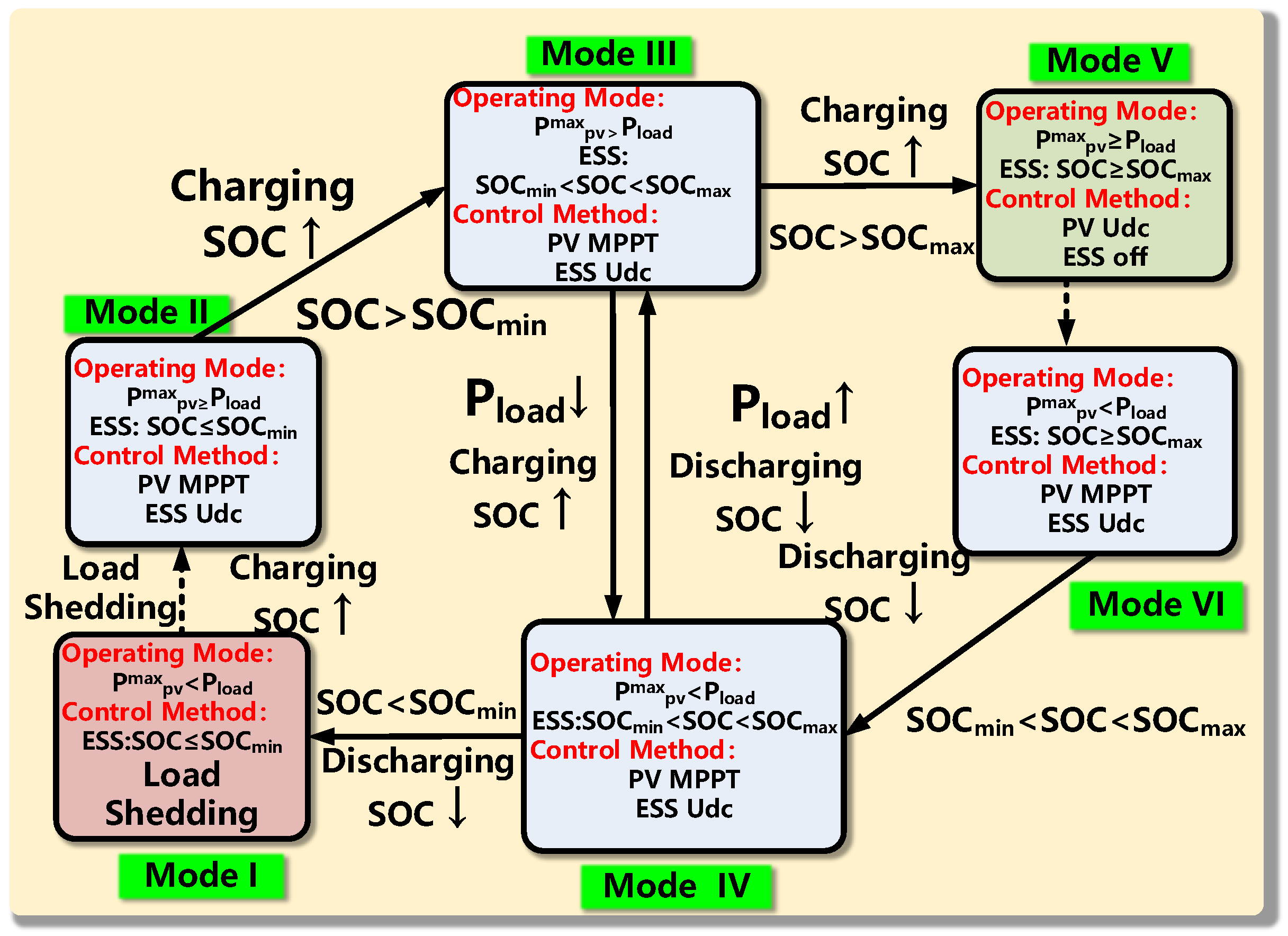

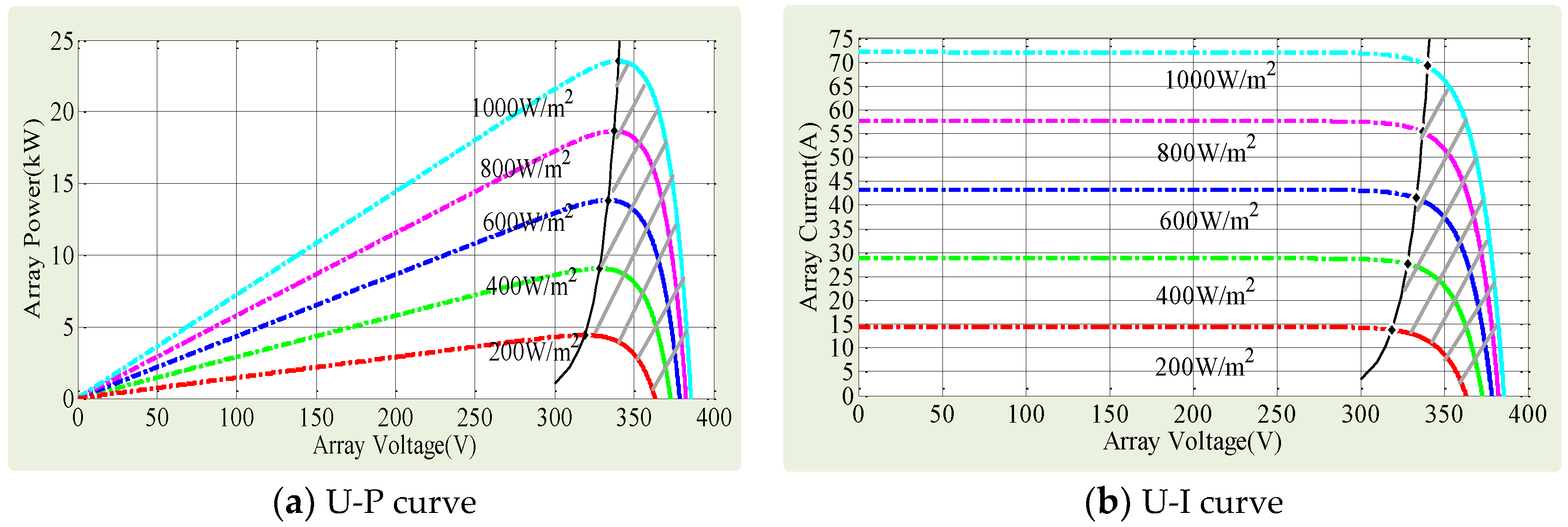

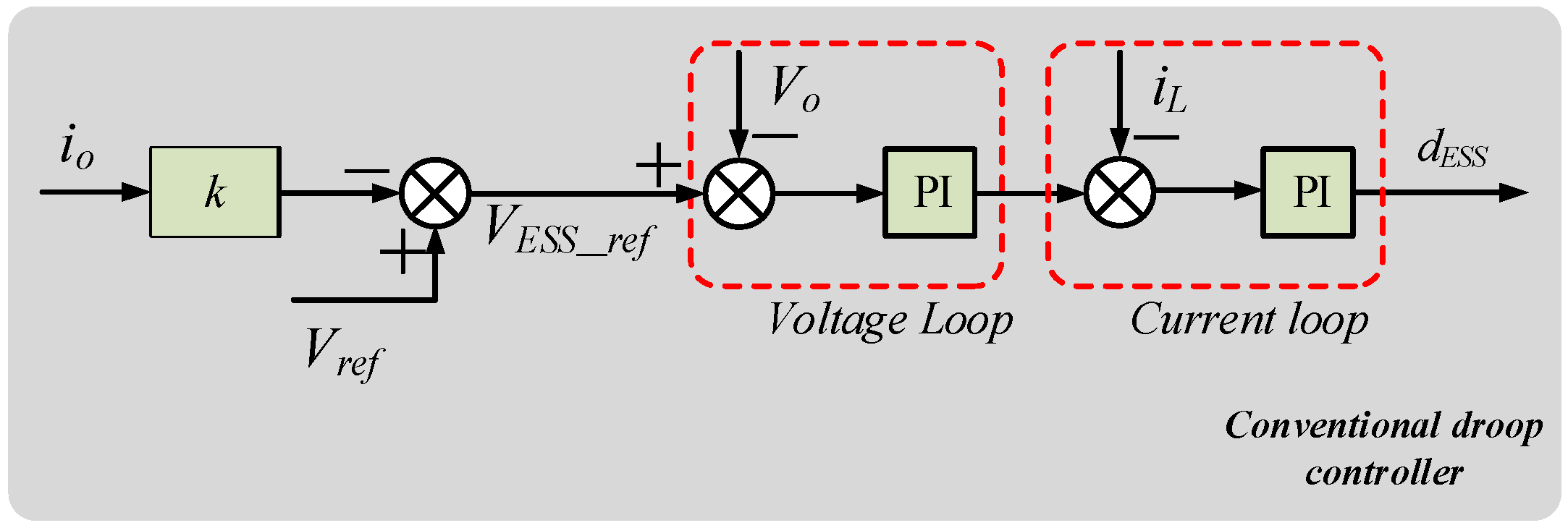
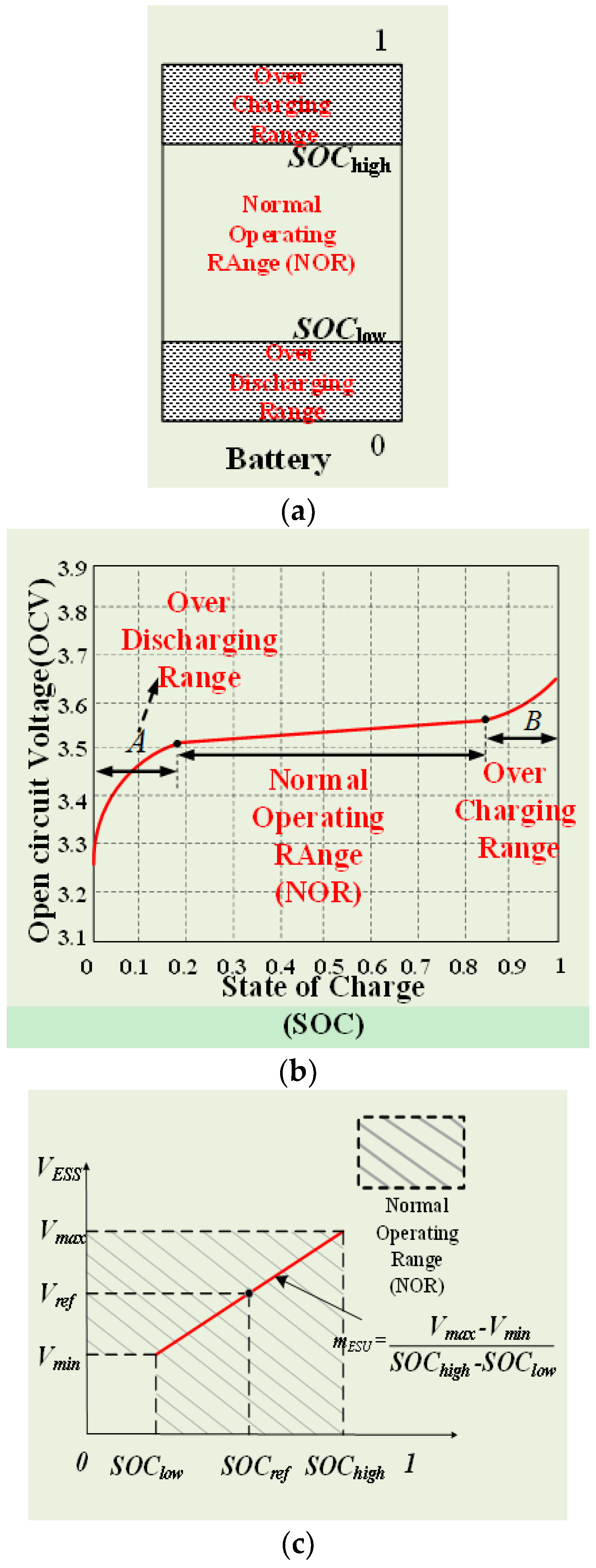

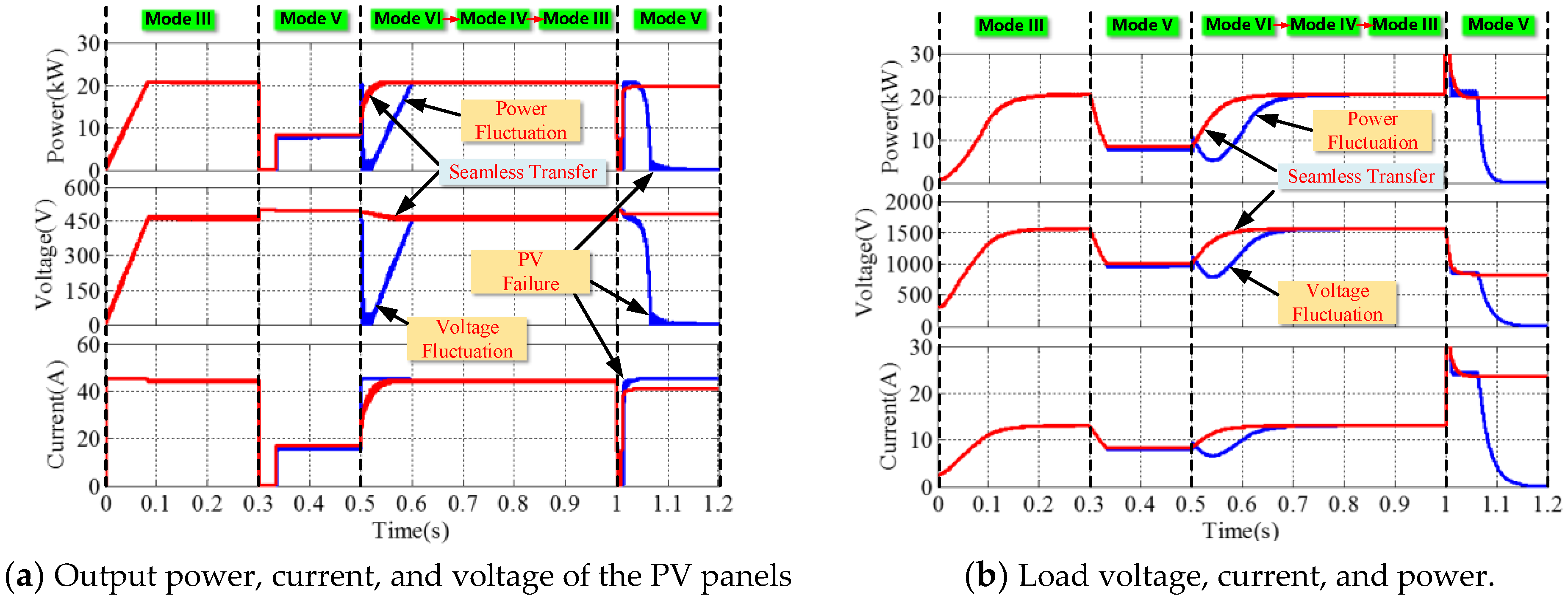

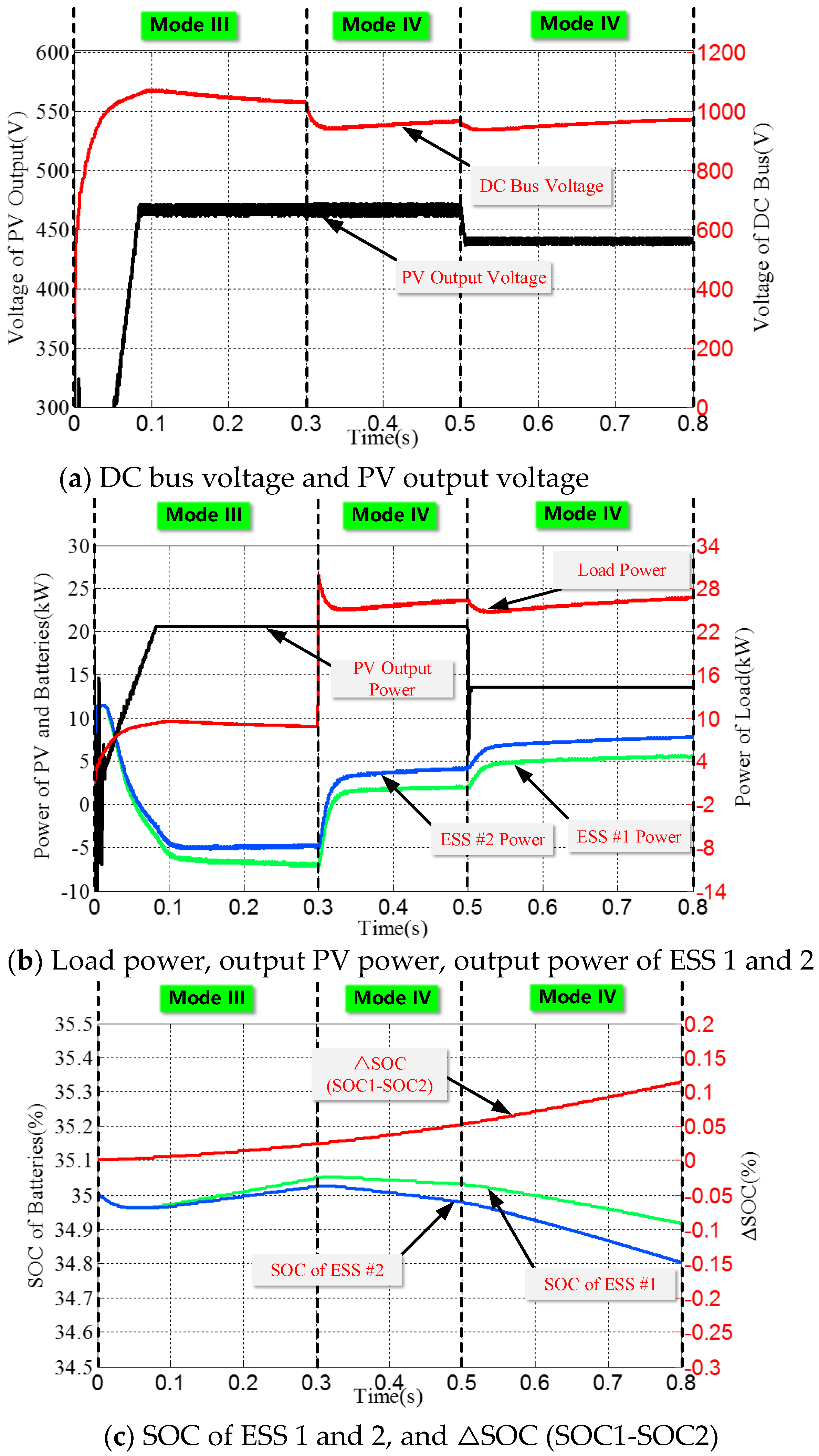
| Parameter | Value | |
|---|---|---|
| PV | Vocn (PV open-circuit voltage) | 500 V |
| Iscn (PV short-circuit current) | 48 A | |
| VMPP (MPP voltage) | 465 V | |
| IMPP (MPP current) | 45 A | |
| VMPP (MPP power) | 20.9 kW | |
| PV input capacitance | 330 μF | |
| PV output capacitance | 730 μF | |
| PV inductance | 3 mH | |
| ESS | Battery input capacitance | 330 μF |
| Battery output capacitor | 630 μF | |
| Battery inductor | 1 mH | |
| SOCmax | 0.8 | |
| SOCmin | 0.2 | |
| Control parameter | Kp (PV boost convert) Ki (PV boost convert) | 0.31 12.2 |
| Kp (Bi-DC-DC convert) Ki (Bi-DC-DC convert) | 5.72 0.325 | |
| Ka | 0.001 |
| Incident | Time (s) | Mode | PV Control Strategy and Load Resistance |
|---|---|---|---|
| 1 | 0–0.3 | III | MPPT, Rl = 120 Ω |
| 2 | 0.3–0.5 | V | MPPT−Udc, Rl = 120 Ω |
| 3 | 0.5–1.0 | VI→IV→III | Udc−MPPT, Rl = 120 Ω |
| 4 | 1.0–1.2 | V | MPPT−Udc, Rl = 35 Ω |
| Incident | Time (s) | Mode | Working Condition |
|---|---|---|---|
| 1 | 0–0.2 | V | S = 1 kW/m2, Rl = 120 Ω |
| 2 | 0.2–0.5 | VI | S = 1 kW/m2, Rl = 35 Ω |
| 3 | 0.5–0.8 | IV | S = 0.7 kW/m2, Rl = 35 Ω |
| Incident | Time (s) | Mode | Working Condition |
|---|---|---|---|
| 1 | 0–0.3 | III | S = 1 kW/m2, Rl = 120 Ω |
| 2 | 0.3–0.5 | IV | S = 1 kW/m2, Rl = 35 Ω |
| 3 | 0.5–0.8 | IV | S = 0.7 kW/m2, Rl = 35 Ω |
© 2018 by the authors. Licensee MDPI, Basel, Switzerland. This article is an open access article distributed under the terms and conditions of the Creative Commons Attribution (CC BY) license (http://creativecommons.org/licenses/by/4.0/).
Share and Cite
Chen, M.; Ma, S.; Wan, H.; Wu, J.; Jiang, Y. Distributed Control Strategy for DC Microgrids of Photovoltaic Energy Storage Systems in Off-Grid Operation. Energies 2018, 11, 2637. https://doi.org/10.3390/en11102637
Chen M, Ma S, Wan H, Wu J, Jiang Y. Distributed Control Strategy for DC Microgrids of Photovoltaic Energy Storage Systems in Off-Grid Operation. Energies. 2018; 11(10):2637. https://doi.org/10.3390/en11102637
Chicago/Turabian StyleChen, Mingxuan, Suliang Ma, Haiyong Wan, Jianwen Wu, and Yuan Jiang. 2018. "Distributed Control Strategy for DC Microgrids of Photovoltaic Energy Storage Systems in Off-Grid Operation" Energies 11, no. 10: 2637. https://doi.org/10.3390/en11102637





